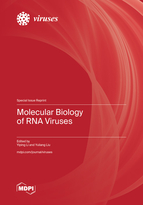Molecular Biology of RNA Viruses
A special issue of Viruses (ISSN 1999-4915). This special issue belongs to the section "General Virology".
Deadline for manuscript submissions: closed (30 June 2023) | Viewed by 25526
Special Issue Editors
Interests: life cycle of RNA viruses; virus–host interaction; Flaviviridae viruses; coronaviruses; vector-borne viruses; RNA modifications; reverse genetic systems; infection models; antiviral drugs; antiviral immunity; antibodies
Interests: virus–host interactions; reverse-genetics; vaccine development; reference material; avian influenza virus; Ebola virus; Newcastle disease virus; African swine fever virus; diagnostic technology; animal diseases
Special Issue Information
Dear Colleagues,
RNA viruses possess ribonucleic acid as their genetic material and constitute a large proportion of the known viruses. New RNA viruses are continually discovered, accelerated by the establishment and application of novel genetic identification technology, such as next-generation sequencing. RNA viruses infect humans, animals, plants, and other microorganisms, and medically and agriculturally important RNA viruses have caused immeasurable health problems and socioeconomic losses worldwide. The worst example is probably the ongoing COVID-19 pandemic.
RNA viruses are diverse mostly in their genomic organization, including segmented or non-segmented; positive, negative, or ambisense; and single- or double-stranded RNAs. Other characteristics include their replication mechanisms, which commonly depend on the RNA-dependent RNA-polymerase to generate RNA intermediates required to replicate their RNA genomes. The viral life cycle includes, at a minimum, RNA replication, translation, precursor protein processing, RNA packaging, morphogenesis and the release of virions, which is completed in the infected host cells. The functions of viral RNA elements and proteins, as well as their interaction with host factors, also correlate with the pathogenesis of the virus. Understanding the molecular virology of RNA viruses is vitally important, as it lays the foundation for the development of strategies of therapeutics, prevention and control or of maintaining a balance of commensalism without causing harm or damage to the host.
Research on the molecular biology of RNA viruses has achieved great progression, especially in animal and human pathogenic RNA viruses (human immunodeficiency virus, hepatitis C virus, dengue virus, Zika virus, influenza virus, coronaviruses, etc.). Scientists worldwide have developed new technologies or adopted state-of-the-art technology and interdisciplinary concepts to study RNA viruses at the molecular level. Accumulating research outcomes have rapidly improved our understanding of various aspects of RNA viruses, particularly our knowledge of the molecular biology of RNA viruses.
To present and share the most up-to-date progress on the molecular biology of RNA viruses with the community, it is expedient to launch a Special Issue on "Molecular Biology of RNA Viruses" in the journal Viruses. This Special Issue will collect excellent and high-impact research findings on RNA viruses including, but not limited to, the life cycle of RNA viruses, functions of viral RNA or proteins, virus–host interaction, host tropism, RNA modifications, reverse genetic platforms, infection models, antiviral drugs, drug resistance, antiviral immunity, and the pathogenesis of RNA viruses.
Aims and Scope (not an exhaustive list):
- Mechanism of viral life cycle (e.g., infection, replication, packaging, budding).
- Virus–host interactions.
- Virus–viral protein interactions.
- RNA modification.
- Viral protein biology.
- Emerging and reemerging RNA viruses.
- Infection models.
We thank you in advance for your contributions.
Prof. Dr. Yiping Li
Prof. Dr. Yuliang Liu
Guest Editors
Manuscript Submission Information
Manuscripts should be submitted online at www.mdpi.com by registering and logging in to this website. Once you are registered, click here to go to the submission form. Manuscripts can be submitted until the deadline. All submissions that pass pre-check are peer-reviewed. Accepted papers will be published continuously in the journal (as soon as accepted) and will be listed together on the special issue website. Research articles, review articles as well as short communications are invited. For planned papers, a title and short abstract (about 100 words) can be sent to the Editorial Office for announcement on this website.
Submitted manuscripts should not have been published previously, nor be under consideration for publication elsewhere (except conference proceedings papers). All manuscripts are thoroughly refereed through a single-blind peer-review process. A guide for authors and other relevant information for submission of manuscripts is available on the Instructions for Authors page. Viruses is an international peer-reviewed open access monthly journal published by MDPI.
Please visit the Instructions for Authors page before submitting a manuscript. The Article Processing Charge (APC) for publication in this open access journal is 2600 CHF (Swiss Francs). Submitted papers should be well formatted and use good English. Authors may use MDPI's English editing service prior to publication or during author revisions.
Keywords
- RNA viruses
- Molecular biology
- Viral membrane/capsid/structural protein
- Viral gene functions
- Viral life cycle








